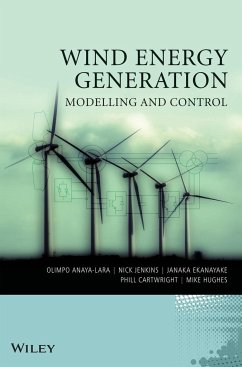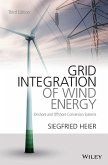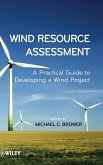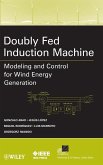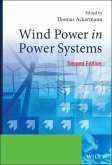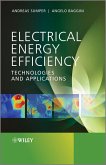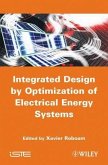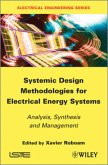Olimpo Anaya-Lara, Nick Jenkins, Janaka Ekanayake, Phill Cartwright, Michael Hughes
Wind Energy Generation: Modelling and Control
Olimpo Anaya-Lara, Nick Jenkins, Janaka Ekanayake, Phill Cartwright, Michael Hughes
Wind Energy Generation: Modelling and Control
- Gebundenes Buch
- Merkliste
- Auf die Merkliste
- Bewerten Bewerten
- Teilen
- Produkt teilen
- Produkterinnerung
- Produkterinnerung
With increasing concern over climate change and the security of energy supplies, wind power is emerging as an important source of electrical energy throughout the world.
Modern wind turbines use advanced power electronics to provide efficient generator control and to ensure compatible operation with the power system. Wind Energy Generation describes the fundamental principles and modelling of the electrical generator and power electronic systems used in large wind turbines. It also discusses how they interact with the power system and the influence of wind turbines on power system operation…mehr
Andere Kunden interessierten sich auch für
![Grid Integration of Wind Energy Grid Integration of Wind Energy]() Siegfried HeierGrid Integration of Wind Energy152,99 €
Siegfried HeierGrid Integration of Wind Energy152,99 €![Wind Resource Assessment Wind Resource Assessment]() Michael BrowerWind Resource Assessment115,99 €
Michael BrowerWind Resource Assessment115,99 €![Doubly Fed Induction Machine Doubly Fed Induction Machine]() Gonzalo AbadDoubly Fed Induction Machine165,99 €
Gonzalo AbadDoubly Fed Induction Machine165,99 €![Wind Power in Power Systems Wind Power in Power Systems]() Wind Power in Power Systems202,99 €
Wind Power in Power Systems202,99 €![Electrical Energy Efficiency Electrical Energy Efficiency]() Andreas M. SumperElectrical Energy Efficiency131,99 €
Andreas M. SumperElectrical Energy Efficiency131,99 €![Integrated Design by Optimization of Electrical Energy Systems Integrated Design by Optimization of Electrical Energy Systems]() Integrated Design by Optimization of Electrical Energy Systems190,99 €
Integrated Design by Optimization of Electrical Energy Systems190,99 €![Systemic Design Methodologies for Electrical Energy Systems Systemic Design Methodologies for Electrical Energy Systems]() Systemic Design Methodologies for Electrical Energy Systems190,99 €
Systemic Design Methodologies for Electrical Energy Systems190,99 €-
-
-
With increasing concern over climate change and the security of energy supplies, wind power is emerging as an important source of electrical energy throughout the world.
Modern wind turbines use advanced power electronics to provide efficient generator control and to ensure compatible operation with the power system. Wind Energy Generation describes the fundamental principles and modelling of the electrical generator and power electronic systems used in large wind turbines. It also discusses how they interact with the power system and the influence of wind turbines on power system operation and stability.
Key features:
Includes a comprehensive account of power electronic equipment used in wind turbines and for their grid connection.
Describes enabling technologies which facilitate the connection of large-scale onshore and offshore wind farms.
Provides detailed modelling and control of wind turbine systems.
Shows a number of simulations and case studies which explain the dynamic interaction between wind power and conventional generation.
Hinweis: Dieser Artikel kann nur an eine deutsche Lieferadresse ausgeliefert werden.
Modern wind turbines use advanced power electronics to provide efficient generator control and to ensure compatible operation with the power system. Wind Energy Generation describes the fundamental principles and modelling of the electrical generator and power electronic systems used in large wind turbines. It also discusses how they interact with the power system and the influence of wind turbines on power system operation and stability.
Key features:
Includes a comprehensive account of power electronic equipment used in wind turbines and for their grid connection.
Describes enabling technologies which facilitate the connection of large-scale onshore and offshore wind farms.
Provides detailed modelling and control of wind turbine systems.
Shows a number of simulations and case studies which explain the dynamic interaction between wind power and conventional generation.
Hinweis: Dieser Artikel kann nur an eine deutsche Lieferadresse ausgeliefert werden.
Produktdetails
- Produktdetails
- Verlag: Wiley & Sons
- 1. Auflage
- Seitenzahl: 288
- Erscheinungstermin: 1. September 2009
- Englisch
- Abmessung: 250mm x 175mm x 20mm
- Gewicht: 628g
- ISBN-13: 9780470714331
- ISBN-10: 0470714336
- Artikelnr.: 27669215
- Herstellerkennzeichnung
- Libri GmbH
- Europaallee 1
- 36244 Bad Hersfeld
- gpsr@libri.de
- Verlag: Wiley & Sons
- 1. Auflage
- Seitenzahl: 288
- Erscheinungstermin: 1. September 2009
- Englisch
- Abmessung: 250mm x 175mm x 20mm
- Gewicht: 628g
- ISBN-13: 9780470714331
- ISBN-10: 0470714336
- Artikelnr.: 27669215
- Herstellerkennzeichnung
- Libri GmbH
- Europaallee 1
- 36244 Bad Hersfeld
- gpsr@libri.de
OLIMPO ANAYA-LARA, University Of Strathclyde, Glasgow, UK NICK JENKINS, Cardiff University. UK JANAKA EKANAYAKE, Cardiff University, UK PHILL CARTWRIGHT, Rolls-Royce plc. UK MIKE HUGHES, Consultant and Imperial College London, UK
About the Authors xi
Preface xiii
Acronyms and Symbols xv
1 Electricity Generation from Wind Energy 1
1.1 Wind Farms 2
1.2 Wind Energy-generating Systems 3
1.2.1 Wind Turbines 3
1.2.2 Wind Turbine Architectures 7
1.3 Wind Generators Compared with Conventional Power Plant 10
1.3.1 Local Impacts 11
1.3.2 System-wide Impacts 13
1.4 Grid Code Regulations for the Integration of Wind Generation 14
References 17
2 Power Electronics for Wind Turbines 19
2.1 Soft-starter for FSIG Wind Turbines 21
2.2 Voltage Source Converters (VSCs) 21
2.2.1 The Two-level VSC 21
2.2.2 Square-wave Operation 24
2.2.3 Carrier-based PWM (CB-PWM) 25
2.2.4 Switching Frequency Optimal PWM (SFO-PWM) 27
2.2.5 Regular and Non-regular Sampled PWM (RS-PWM and NRS-PWM) 28
2.2.6 Selective Harmonic Elimination PWM (SHEM) 29
2.2.7 Voltage Space Vector Switching (SV-PWM) 30
2.2.8 Hysteresis Switching 33
2.3 Application of VSCs for Variable-speed Systems 33
2.3.1 VSC with a Diode Bridge 34
2.3.2 Back-to-Back VSCs 34
References 36
3 Modelling of Synchronous Generators 39
3.1 Synchronous Generator Construction 39
3.2 The Air-gap Magnetic Field of the Synchronous Generator 39
3.3 Coil Representation of the Synchronous Generator 42
3.4 Generator Equations in the dq Frame 44
3.4.1 Generator Electromagnetic Torque 47
3.5 Steady-state Operation 47
3.6 Synchronous Generator with Damper Windings 49
3.7 Non-reduced Order Model 51
3.8 Reduced-order Model 52
3.9 Control of Large Synchronous Generators 53
3.9.1 Excitation Control 53
3.9.2 Prime Mover Control 55
References 56
4 Fixed-speed Induction Generator (FSIG)-based Wind Turbines 57
4.1 Induction Machine Construction 57
4.1.1 Squirrel-cage Rotor 58
4.1.2 Wound Rotor 58
4.2 Steady-state Characteristics 58
4.2.1 Variations in Generator Terminal Voltage 61
4.3 FSIG Configurations for Wind Generation 61
4.3.1 Two-speed Operation 62
4.3.2 Variable-slip Operation 63
4.3.3 Reactive Power Compensation Equipment 64
4.4 Induction Machine Modelling 64
4.4.1 FSIG Model as a Voltage Behind a Transient Reactance 65
4.5 Dynamic Performance of FSIG Wind Turbines 70
4.5.1 Small Disturbances 70
4.5.2 Performance During Network Faults 73
References 76
5 Doubly Fed Induction Generator (DFIG)-based Wind Turbines 77
5.1 Typical DFIG Configuration 77
5.2 Steady-state Characteristics 77
5.2.1 Active Power Relationships in the Steady State 80
5.2.2 Vector Diagram of Operating Conditions 81
5.3 Control for Optimum Wind Power Extraction 83
5.4 Control Strategies for a DFIG 84
5.4.1 Current-mode Control (PVdq) 84
5.4.2 Rotor Flux Magnitude and Angle Control 89
5.5 Dynamic Performance Assessment 90
5.5.1 Small Disturbances 91
5.5.2 Performance During Network Faults 94
References 96
6 Fully Rated Converter-based (FRC) Wind Turbines 99
6.1 FRC Synchronous Generator-based (FRC-SG) Wind Turbine 100
6.1.1 Direct-driven Wind Turbine Generators 100
6.1.2 Permanent Magnets Versus Electrically Excited Synchronous Generators
101
6.1.3 Permanent Magnet Synchronous Generator 101
6.1.4 Wind Turbine Control and Dynamic Performance Assessment 103
6.2 FRC Induction Generator-based (FRC-IG) Wind Turbine 113
6.2.1 Steady-state Performance 113
6.2.2 Control of the FRC-IG Wind Turbine 114
6.2.3 Performance Characteristics of the FRC-IG Wind Turbine 119
References 119
7 Influence of Rotor Dynamics on Wind Turbine Operation 121
7.1 Blade Bending Dynamics 122
7.2 Derivation of Three-mass Model 123
7.2.1 Example: 300 kW FSIG Wind Turbine 124
7.3 Effective Two-mass Model 126
7.4 Assessment of FSIG and DFIG Wind Turbine Performance 128
Acknowledgement 132
References 132
8 Influence of Wind Farms on Network Dynamic Performance 135
8.1 Dynamic Stability and its Assessment 135
8.2 Dynamic Characteristics of Synchronous Generation 136
8.3 A Synchronizing Power and Damping Power Model of a Synchronous
Generator 137
8.4 Influence of Automatic Voltage Regulator on Damping 139
8.5 Influence on Damping of Generator Operating Conditions 141
8.6 Influence of Turbine Governor on Generator Operation 143
8.7 Transient Stability 145
8.8 Voltage Stability 147
8.9 Generic Test Network 149
8.10 Influence of Generation Type on Network Dynamic Stability 150
8.10.1 Generator 2 - Synchronous Generator 151
8.10.2 Generator 2 - FSIG-based Wind Farm 152
8.10.3 Generator 2 - DFIG-based Wind Farm (PVdq Control) 152
8.10.4 Generator 2 - DFIG-based Wind Farm (FMAC Control) 152
8.10.5 Generator 2 - FRC-based Wind Farm 152
8.11 Dynamic Interaction of Wind Farms with the Network 153
8.11.1 FSIG Influence on Network Damping 153
8.11.2 DFIG Influence on Network Damping 158
8.12 Influence of Wind Generation on Network Transient Performance 161
8.12.1 Generator 2 - Synchronous Generator 161
8.12.2 Generator 2 - FSIG Wind Farm 162
8.12.3 Generator 2 - DFIG Wind Farm 163
8.12.4 Generator 2 - FRC Wind Farm 165
References 165
9 Power Systems Stabilizers and Network Damping Capability of Wind Farms
167
9.1 A Power System Stabilizer for a Synchronous Generator 167
9.1.1 Requirements and Function 167
9.1.2 Synchronous Generator PSS and its Performance Contributions 169
9.2 A Power System Stabilizer for a DFIG 172
9.2.1 Requirements and Function 172
9.2.2 DFIG-PSS and its Performance Contributions 178
9.3 A Power System Stabilizer for an FRC Wind Farm 182
9.3.1 Requirements and Functions 182
9.3.2 FRC-PSS and its Performance Contributions 186
References 191
10 The Integration of Wind Farms into the Power System 193
10.1 Reactive Power Compensation 193
10.1.1 Static Var Compensator (SVC) 194
10.1.2 Static Synchronous Compensator (STATCOM) 195
10.1.3 STATCOM and FSIG Stability 197
10.2 HVAC Connections 198
10.3 HVDC Connections 198
10.3.1 LCC-HVDC 200
10.3.2 VSC-HVDC 201
10.3.3 Multi-terminal HVDC 203
10.3.4 HVDC Transmission - Opportunities and Challenges 204
10.4 Example of the Design of a Submarine Network 207
10.4.1 Beatrice Offshore Wind Farm 207
10.4.2 Onshore Grid Connection Points 208
10.4.3 Technical Analysis 210
10.4.4 Cost Analysis 212
10.4.5 Recommended Point of Connection 213
Acknowledgement 214
References 214
11 Wind Turbine Control for System Contingencies 217
11.1 Contribution of Wind Generation to Frequency Regulation 217
11.1.1 Frequency Control 217
11.1.2 Wind Turbine Inertia 218
11.1.3 Fast Primary Response 219
11.1.4 Slow Primary Response 222
11.2 Fault Ride-through (FRT) 228
11.2.1 FSIGs 228
11.2.2 DFIGs 229
11.2.3 FRCs 231
11.2.4 VSC-HVDC with FSIG Wind Farm 233
11.2.5 FRC Wind Turbines Connected Via a VSC-HVDC 234
References 237
Appendix A: State-Space Concepts and Models 241
Appendix B: Introduction to Eigenvalues and Eigenvectors 249
Appendix C: Linearization of State Equations 255
Appendix D: Generic Network Model Parameters 259
Index 265
Preface xiii
Acronyms and Symbols xv
1 Electricity Generation from Wind Energy 1
1.1 Wind Farms 2
1.2 Wind Energy-generating Systems 3
1.2.1 Wind Turbines 3
1.2.2 Wind Turbine Architectures 7
1.3 Wind Generators Compared with Conventional Power Plant 10
1.3.1 Local Impacts 11
1.3.2 System-wide Impacts 13
1.4 Grid Code Regulations for the Integration of Wind Generation 14
References 17
2 Power Electronics for Wind Turbines 19
2.1 Soft-starter for FSIG Wind Turbines 21
2.2 Voltage Source Converters (VSCs) 21
2.2.1 The Two-level VSC 21
2.2.2 Square-wave Operation 24
2.2.3 Carrier-based PWM (CB-PWM) 25
2.2.4 Switching Frequency Optimal PWM (SFO-PWM) 27
2.2.5 Regular and Non-regular Sampled PWM (RS-PWM and NRS-PWM) 28
2.2.6 Selective Harmonic Elimination PWM (SHEM) 29
2.2.7 Voltage Space Vector Switching (SV-PWM) 30
2.2.8 Hysteresis Switching 33
2.3 Application of VSCs for Variable-speed Systems 33
2.3.1 VSC with a Diode Bridge 34
2.3.2 Back-to-Back VSCs 34
References 36
3 Modelling of Synchronous Generators 39
3.1 Synchronous Generator Construction 39
3.2 The Air-gap Magnetic Field of the Synchronous Generator 39
3.3 Coil Representation of the Synchronous Generator 42
3.4 Generator Equations in the dq Frame 44
3.4.1 Generator Electromagnetic Torque 47
3.5 Steady-state Operation 47
3.6 Synchronous Generator with Damper Windings 49
3.7 Non-reduced Order Model 51
3.8 Reduced-order Model 52
3.9 Control of Large Synchronous Generators 53
3.9.1 Excitation Control 53
3.9.2 Prime Mover Control 55
References 56
4 Fixed-speed Induction Generator (FSIG)-based Wind Turbines 57
4.1 Induction Machine Construction 57
4.1.1 Squirrel-cage Rotor 58
4.1.2 Wound Rotor 58
4.2 Steady-state Characteristics 58
4.2.1 Variations in Generator Terminal Voltage 61
4.3 FSIG Configurations for Wind Generation 61
4.3.1 Two-speed Operation 62
4.3.2 Variable-slip Operation 63
4.3.3 Reactive Power Compensation Equipment 64
4.4 Induction Machine Modelling 64
4.4.1 FSIG Model as a Voltage Behind a Transient Reactance 65
4.5 Dynamic Performance of FSIG Wind Turbines 70
4.5.1 Small Disturbances 70
4.5.2 Performance During Network Faults 73
References 76
5 Doubly Fed Induction Generator (DFIG)-based Wind Turbines 77
5.1 Typical DFIG Configuration 77
5.2 Steady-state Characteristics 77
5.2.1 Active Power Relationships in the Steady State 80
5.2.2 Vector Diagram of Operating Conditions 81
5.3 Control for Optimum Wind Power Extraction 83
5.4 Control Strategies for a DFIG 84
5.4.1 Current-mode Control (PVdq) 84
5.4.2 Rotor Flux Magnitude and Angle Control 89
5.5 Dynamic Performance Assessment 90
5.5.1 Small Disturbances 91
5.5.2 Performance During Network Faults 94
References 96
6 Fully Rated Converter-based (FRC) Wind Turbines 99
6.1 FRC Synchronous Generator-based (FRC-SG) Wind Turbine 100
6.1.1 Direct-driven Wind Turbine Generators 100
6.1.2 Permanent Magnets Versus Electrically Excited Synchronous Generators
101
6.1.3 Permanent Magnet Synchronous Generator 101
6.1.4 Wind Turbine Control and Dynamic Performance Assessment 103
6.2 FRC Induction Generator-based (FRC-IG) Wind Turbine 113
6.2.1 Steady-state Performance 113
6.2.2 Control of the FRC-IG Wind Turbine 114
6.2.3 Performance Characteristics of the FRC-IG Wind Turbine 119
References 119
7 Influence of Rotor Dynamics on Wind Turbine Operation 121
7.1 Blade Bending Dynamics 122
7.2 Derivation of Three-mass Model 123
7.2.1 Example: 300 kW FSIG Wind Turbine 124
7.3 Effective Two-mass Model 126
7.4 Assessment of FSIG and DFIG Wind Turbine Performance 128
Acknowledgement 132
References 132
8 Influence of Wind Farms on Network Dynamic Performance 135
8.1 Dynamic Stability and its Assessment 135
8.2 Dynamic Characteristics of Synchronous Generation 136
8.3 A Synchronizing Power and Damping Power Model of a Synchronous
Generator 137
8.4 Influence of Automatic Voltage Regulator on Damping 139
8.5 Influence on Damping of Generator Operating Conditions 141
8.6 Influence of Turbine Governor on Generator Operation 143
8.7 Transient Stability 145
8.8 Voltage Stability 147
8.9 Generic Test Network 149
8.10 Influence of Generation Type on Network Dynamic Stability 150
8.10.1 Generator 2 - Synchronous Generator 151
8.10.2 Generator 2 - FSIG-based Wind Farm 152
8.10.3 Generator 2 - DFIG-based Wind Farm (PVdq Control) 152
8.10.4 Generator 2 - DFIG-based Wind Farm (FMAC Control) 152
8.10.5 Generator 2 - FRC-based Wind Farm 152
8.11 Dynamic Interaction of Wind Farms with the Network 153
8.11.1 FSIG Influence on Network Damping 153
8.11.2 DFIG Influence on Network Damping 158
8.12 Influence of Wind Generation on Network Transient Performance 161
8.12.1 Generator 2 - Synchronous Generator 161
8.12.2 Generator 2 - FSIG Wind Farm 162
8.12.3 Generator 2 - DFIG Wind Farm 163
8.12.4 Generator 2 - FRC Wind Farm 165
References 165
9 Power Systems Stabilizers and Network Damping Capability of Wind Farms
167
9.1 A Power System Stabilizer for a Synchronous Generator 167
9.1.1 Requirements and Function 167
9.1.2 Synchronous Generator PSS and its Performance Contributions 169
9.2 A Power System Stabilizer for a DFIG 172
9.2.1 Requirements and Function 172
9.2.2 DFIG-PSS and its Performance Contributions 178
9.3 A Power System Stabilizer for an FRC Wind Farm 182
9.3.1 Requirements and Functions 182
9.3.2 FRC-PSS and its Performance Contributions 186
References 191
10 The Integration of Wind Farms into the Power System 193
10.1 Reactive Power Compensation 193
10.1.1 Static Var Compensator (SVC) 194
10.1.2 Static Synchronous Compensator (STATCOM) 195
10.1.3 STATCOM and FSIG Stability 197
10.2 HVAC Connections 198
10.3 HVDC Connections 198
10.3.1 LCC-HVDC 200
10.3.2 VSC-HVDC 201
10.3.3 Multi-terminal HVDC 203
10.3.4 HVDC Transmission - Opportunities and Challenges 204
10.4 Example of the Design of a Submarine Network 207
10.4.1 Beatrice Offshore Wind Farm 207
10.4.2 Onshore Grid Connection Points 208
10.4.3 Technical Analysis 210
10.4.4 Cost Analysis 212
10.4.5 Recommended Point of Connection 213
Acknowledgement 214
References 214
11 Wind Turbine Control for System Contingencies 217
11.1 Contribution of Wind Generation to Frequency Regulation 217
11.1.1 Frequency Control 217
11.1.2 Wind Turbine Inertia 218
11.1.3 Fast Primary Response 219
11.1.4 Slow Primary Response 222
11.2 Fault Ride-through (FRT) 228
11.2.1 FSIGs 228
11.2.2 DFIGs 229
11.2.3 FRCs 231
11.2.4 VSC-HVDC with FSIG Wind Farm 233
11.2.5 FRC Wind Turbines Connected Via a VSC-HVDC 234
References 237
Appendix A: State-Space Concepts and Models 241
Appendix B: Introduction to Eigenvalues and Eigenvectors 249
Appendix C: Linearization of State Equations 255
Appendix D: Generic Network Model Parameters 259
Index 265
About the Authors xi
Preface xiii
Acronyms and Symbols xv
1 Electricity Generation from Wind Energy 1
1.1 Wind Farms 2
1.2 Wind Energy-generating Systems 3
1.2.1 Wind Turbines 3
1.2.2 Wind Turbine Architectures 7
1.3 Wind Generators Compared with Conventional Power Plant 10
1.3.1 Local Impacts 11
1.3.2 System-wide Impacts 13
1.4 Grid Code Regulations for the Integration of Wind Generation 14
References 17
2 Power Electronics for Wind Turbines 19
2.1 Soft-starter for FSIG Wind Turbines 21
2.2 Voltage Source Converters (VSCs) 21
2.2.1 The Two-level VSC 21
2.2.2 Square-wave Operation 24
2.2.3 Carrier-based PWM (CB-PWM) 25
2.2.4 Switching Frequency Optimal PWM (SFO-PWM) 27
2.2.5 Regular and Non-regular Sampled PWM (RS-PWM and NRS-PWM) 28
2.2.6 Selective Harmonic Elimination PWM (SHEM) 29
2.2.7 Voltage Space Vector Switching (SV-PWM) 30
2.2.8 Hysteresis Switching 33
2.3 Application of VSCs for Variable-speed Systems 33
2.3.1 VSC with a Diode Bridge 34
2.3.2 Back-to-Back VSCs 34
References 36
3 Modelling of Synchronous Generators 39
3.1 Synchronous Generator Construction 39
3.2 The Air-gap Magnetic Field of the Synchronous Generator 39
3.3 Coil Representation of the Synchronous Generator 42
3.4 Generator Equations in the dq Frame 44
3.4.1 Generator Electromagnetic Torque 47
3.5 Steady-state Operation 47
3.6 Synchronous Generator with Damper Windings 49
3.7 Non-reduced Order Model 51
3.8 Reduced-order Model 52
3.9 Control of Large Synchronous Generators 53
3.9.1 Excitation Control 53
3.9.2 Prime Mover Control 55
References 56
4 Fixed-speed Induction Generator (FSIG)-based Wind Turbines 57
4.1 Induction Machine Construction 57
4.1.1 Squirrel-cage Rotor 58
4.1.2 Wound Rotor 58
4.2 Steady-state Characteristics 58
4.2.1 Variations in Generator Terminal Voltage 61
4.3 FSIG Configurations for Wind Generation 61
4.3.1 Two-speed Operation 62
4.3.2 Variable-slip Operation 63
4.3.3 Reactive Power Compensation Equipment 64
4.4 Induction Machine Modelling 64
4.4.1 FSIG Model as a Voltage Behind a Transient Reactance 65
4.5 Dynamic Performance of FSIG Wind Turbines 70
4.5.1 Small Disturbances 70
4.5.2 Performance During Network Faults 73
References 76
5 Doubly Fed Induction Generator (DFIG)-based Wind Turbines 77
5.1 Typical DFIG Configuration 77
5.2 Steady-state Characteristics 77
5.2.1 Active Power Relationships in the Steady State 80
5.2.2 Vector Diagram of Operating Conditions 81
5.3 Control for Optimum Wind Power Extraction 83
5.4 Control Strategies for a DFIG 84
5.4.1 Current-mode Control (PVdq) 84
5.4.2 Rotor Flux Magnitude and Angle Control 89
5.5 Dynamic Performance Assessment 90
5.5.1 Small Disturbances 91
5.5.2 Performance During Network Faults 94
References 96
6 Fully Rated Converter-based (FRC) Wind Turbines 99
6.1 FRC Synchronous Generator-based (FRC-SG) Wind Turbine 100
6.1.1 Direct-driven Wind Turbine Generators 100
6.1.2 Permanent Magnets Versus Electrically Excited Synchronous Generators
101
6.1.3 Permanent Magnet Synchronous Generator 101
6.1.4 Wind Turbine Control and Dynamic Performance Assessment 103
6.2 FRC Induction Generator-based (FRC-IG) Wind Turbine 113
6.2.1 Steady-state Performance 113
6.2.2 Control of the FRC-IG Wind Turbine 114
6.2.3 Performance Characteristics of the FRC-IG Wind Turbine 119
References 119
7 Influence of Rotor Dynamics on Wind Turbine Operation 121
7.1 Blade Bending Dynamics 122
7.2 Derivation of Three-mass Model 123
7.2.1 Example: 300 kW FSIG Wind Turbine 124
7.3 Effective Two-mass Model 126
7.4 Assessment of FSIG and DFIG Wind Turbine Performance 128
Acknowledgement 132
References 132
8 Influence of Wind Farms on Network Dynamic Performance 135
8.1 Dynamic Stability and its Assessment 135
8.2 Dynamic Characteristics of Synchronous Generation 136
8.3 A Synchronizing Power and Damping Power Model of a Synchronous
Generator 137
8.4 Influence of Automatic Voltage Regulator on Damping 139
8.5 Influence on Damping of Generator Operating Conditions 141
8.6 Influence of Turbine Governor on Generator Operation 143
8.7 Transient Stability 145
8.8 Voltage Stability 147
8.9 Generic Test Network 149
8.10 Influence of Generation Type on Network Dynamic Stability 150
8.10.1 Generator 2 - Synchronous Generator 151
8.10.2 Generator 2 - FSIG-based Wind Farm 152
8.10.3 Generator 2 - DFIG-based Wind Farm (PVdq Control) 152
8.10.4 Generator 2 - DFIG-based Wind Farm (FMAC Control) 152
8.10.5 Generator 2 - FRC-based Wind Farm 152
8.11 Dynamic Interaction of Wind Farms with the Network 153
8.11.1 FSIG Influence on Network Damping 153
8.11.2 DFIG Influence on Network Damping 158
8.12 Influence of Wind Generation on Network Transient Performance 161
8.12.1 Generator 2 - Synchronous Generator 161
8.12.2 Generator 2 - FSIG Wind Farm 162
8.12.3 Generator 2 - DFIG Wind Farm 163
8.12.4 Generator 2 - FRC Wind Farm 165
References 165
9 Power Systems Stabilizers and Network Damping Capability of Wind Farms
167
9.1 A Power System Stabilizer for a Synchronous Generator 167
9.1.1 Requirements and Function 167
9.1.2 Synchronous Generator PSS and its Performance Contributions 169
9.2 A Power System Stabilizer for a DFIG 172
9.2.1 Requirements and Function 172
9.2.2 DFIG-PSS and its Performance Contributions 178
9.3 A Power System Stabilizer for an FRC Wind Farm 182
9.3.1 Requirements and Functions 182
9.3.2 FRC-PSS and its Performance Contributions 186
References 191
10 The Integration of Wind Farms into the Power System 193
10.1 Reactive Power Compensation 193
10.1.1 Static Var Compensator (SVC) 194
10.1.2 Static Synchronous Compensator (STATCOM) 195
10.1.3 STATCOM and FSIG Stability 197
10.2 HVAC Connections 198
10.3 HVDC Connections 198
10.3.1 LCC-HVDC 200
10.3.2 VSC-HVDC 201
10.3.3 Multi-terminal HVDC 203
10.3.4 HVDC Transmission - Opportunities and Challenges 204
10.4 Example of the Design of a Submarine Network 207
10.4.1 Beatrice Offshore Wind Farm 207
10.4.2 Onshore Grid Connection Points 208
10.4.3 Technical Analysis 210
10.4.4 Cost Analysis 212
10.4.5 Recommended Point of Connection 213
Acknowledgement 214
References 214
11 Wind Turbine Control for System Contingencies 217
11.1 Contribution of Wind Generation to Frequency Regulation 217
11.1.1 Frequency Control 217
11.1.2 Wind Turbine Inertia 218
11.1.3 Fast Primary Response 219
11.1.4 Slow Primary Response 222
11.2 Fault Ride-through (FRT) 228
11.2.1 FSIGs 228
11.2.2 DFIGs 229
11.2.3 FRCs 231
11.2.4 VSC-HVDC with FSIG Wind Farm 233
11.2.5 FRC Wind Turbines Connected Via a VSC-HVDC 234
References 237
Appendix A: State-Space Concepts and Models 241
Appendix B: Introduction to Eigenvalues and Eigenvectors 249
Appendix C: Linearization of State Equations 255
Appendix D: Generic Network Model Parameters 259
Index 265
Preface xiii
Acronyms and Symbols xv
1 Electricity Generation from Wind Energy 1
1.1 Wind Farms 2
1.2 Wind Energy-generating Systems 3
1.2.1 Wind Turbines 3
1.2.2 Wind Turbine Architectures 7
1.3 Wind Generators Compared with Conventional Power Plant 10
1.3.1 Local Impacts 11
1.3.2 System-wide Impacts 13
1.4 Grid Code Regulations for the Integration of Wind Generation 14
References 17
2 Power Electronics for Wind Turbines 19
2.1 Soft-starter for FSIG Wind Turbines 21
2.2 Voltage Source Converters (VSCs) 21
2.2.1 The Two-level VSC 21
2.2.2 Square-wave Operation 24
2.2.3 Carrier-based PWM (CB-PWM) 25
2.2.4 Switching Frequency Optimal PWM (SFO-PWM) 27
2.2.5 Regular and Non-regular Sampled PWM (RS-PWM and NRS-PWM) 28
2.2.6 Selective Harmonic Elimination PWM (SHEM) 29
2.2.7 Voltage Space Vector Switching (SV-PWM) 30
2.2.8 Hysteresis Switching 33
2.3 Application of VSCs for Variable-speed Systems 33
2.3.1 VSC with a Diode Bridge 34
2.3.2 Back-to-Back VSCs 34
References 36
3 Modelling of Synchronous Generators 39
3.1 Synchronous Generator Construction 39
3.2 The Air-gap Magnetic Field of the Synchronous Generator 39
3.3 Coil Representation of the Synchronous Generator 42
3.4 Generator Equations in the dq Frame 44
3.4.1 Generator Electromagnetic Torque 47
3.5 Steady-state Operation 47
3.6 Synchronous Generator with Damper Windings 49
3.7 Non-reduced Order Model 51
3.8 Reduced-order Model 52
3.9 Control of Large Synchronous Generators 53
3.9.1 Excitation Control 53
3.9.2 Prime Mover Control 55
References 56
4 Fixed-speed Induction Generator (FSIG)-based Wind Turbines 57
4.1 Induction Machine Construction 57
4.1.1 Squirrel-cage Rotor 58
4.1.2 Wound Rotor 58
4.2 Steady-state Characteristics 58
4.2.1 Variations in Generator Terminal Voltage 61
4.3 FSIG Configurations for Wind Generation 61
4.3.1 Two-speed Operation 62
4.3.2 Variable-slip Operation 63
4.3.3 Reactive Power Compensation Equipment 64
4.4 Induction Machine Modelling 64
4.4.1 FSIG Model as a Voltage Behind a Transient Reactance 65
4.5 Dynamic Performance of FSIG Wind Turbines 70
4.5.1 Small Disturbances 70
4.5.2 Performance During Network Faults 73
References 76
5 Doubly Fed Induction Generator (DFIG)-based Wind Turbines 77
5.1 Typical DFIG Configuration 77
5.2 Steady-state Characteristics 77
5.2.1 Active Power Relationships in the Steady State 80
5.2.2 Vector Diagram of Operating Conditions 81
5.3 Control for Optimum Wind Power Extraction 83
5.4 Control Strategies for a DFIG 84
5.4.1 Current-mode Control (PVdq) 84
5.4.2 Rotor Flux Magnitude and Angle Control 89
5.5 Dynamic Performance Assessment 90
5.5.1 Small Disturbances 91
5.5.2 Performance During Network Faults 94
References 96
6 Fully Rated Converter-based (FRC) Wind Turbines 99
6.1 FRC Synchronous Generator-based (FRC-SG) Wind Turbine 100
6.1.1 Direct-driven Wind Turbine Generators 100
6.1.2 Permanent Magnets Versus Electrically Excited Synchronous Generators
101
6.1.3 Permanent Magnet Synchronous Generator 101
6.1.4 Wind Turbine Control and Dynamic Performance Assessment 103
6.2 FRC Induction Generator-based (FRC-IG) Wind Turbine 113
6.2.1 Steady-state Performance 113
6.2.2 Control of the FRC-IG Wind Turbine 114
6.2.3 Performance Characteristics of the FRC-IG Wind Turbine 119
References 119
7 Influence of Rotor Dynamics on Wind Turbine Operation 121
7.1 Blade Bending Dynamics 122
7.2 Derivation of Three-mass Model 123
7.2.1 Example: 300 kW FSIG Wind Turbine 124
7.3 Effective Two-mass Model 126
7.4 Assessment of FSIG and DFIG Wind Turbine Performance 128
Acknowledgement 132
References 132
8 Influence of Wind Farms on Network Dynamic Performance 135
8.1 Dynamic Stability and its Assessment 135
8.2 Dynamic Characteristics of Synchronous Generation 136
8.3 A Synchronizing Power and Damping Power Model of a Synchronous
Generator 137
8.4 Influence of Automatic Voltage Regulator on Damping 139
8.5 Influence on Damping of Generator Operating Conditions 141
8.6 Influence of Turbine Governor on Generator Operation 143
8.7 Transient Stability 145
8.8 Voltage Stability 147
8.9 Generic Test Network 149
8.10 Influence of Generation Type on Network Dynamic Stability 150
8.10.1 Generator 2 - Synchronous Generator 151
8.10.2 Generator 2 - FSIG-based Wind Farm 152
8.10.3 Generator 2 - DFIG-based Wind Farm (PVdq Control) 152
8.10.4 Generator 2 - DFIG-based Wind Farm (FMAC Control) 152
8.10.5 Generator 2 - FRC-based Wind Farm 152
8.11 Dynamic Interaction of Wind Farms with the Network 153
8.11.1 FSIG Influence on Network Damping 153
8.11.2 DFIG Influence on Network Damping 158
8.12 Influence of Wind Generation on Network Transient Performance 161
8.12.1 Generator 2 - Synchronous Generator 161
8.12.2 Generator 2 - FSIG Wind Farm 162
8.12.3 Generator 2 - DFIG Wind Farm 163
8.12.4 Generator 2 - FRC Wind Farm 165
References 165
9 Power Systems Stabilizers and Network Damping Capability of Wind Farms
167
9.1 A Power System Stabilizer for a Synchronous Generator 167
9.1.1 Requirements and Function 167
9.1.2 Synchronous Generator PSS and its Performance Contributions 169
9.2 A Power System Stabilizer for a DFIG 172
9.2.1 Requirements and Function 172
9.2.2 DFIG-PSS and its Performance Contributions 178
9.3 A Power System Stabilizer for an FRC Wind Farm 182
9.3.1 Requirements and Functions 182
9.3.2 FRC-PSS and its Performance Contributions 186
References 191
10 The Integration of Wind Farms into the Power System 193
10.1 Reactive Power Compensation 193
10.1.1 Static Var Compensator (SVC) 194
10.1.2 Static Synchronous Compensator (STATCOM) 195
10.1.3 STATCOM and FSIG Stability 197
10.2 HVAC Connections 198
10.3 HVDC Connections 198
10.3.1 LCC-HVDC 200
10.3.2 VSC-HVDC 201
10.3.3 Multi-terminal HVDC 203
10.3.4 HVDC Transmission - Opportunities and Challenges 204
10.4 Example of the Design of a Submarine Network 207
10.4.1 Beatrice Offshore Wind Farm 207
10.4.2 Onshore Grid Connection Points 208
10.4.3 Technical Analysis 210
10.4.4 Cost Analysis 212
10.4.5 Recommended Point of Connection 213
Acknowledgement 214
References 214
11 Wind Turbine Control for System Contingencies 217
11.1 Contribution of Wind Generation to Frequency Regulation 217
11.1.1 Frequency Control 217
11.1.2 Wind Turbine Inertia 218
11.1.3 Fast Primary Response 219
11.1.4 Slow Primary Response 222
11.2 Fault Ride-through (FRT) 228
11.2.1 FSIGs 228
11.2.2 DFIGs 229
11.2.3 FRCs 231
11.2.4 VSC-HVDC with FSIG Wind Farm 233
11.2.5 FRC Wind Turbines Connected Via a VSC-HVDC 234
References 237
Appendix A: State-Space Concepts and Models 241
Appendix B: Introduction to Eigenvalues and Eigenvectors 249
Appendix C: Linearization of State Equations 255
Appendix D: Generic Network Model Parameters 259
Index 265

